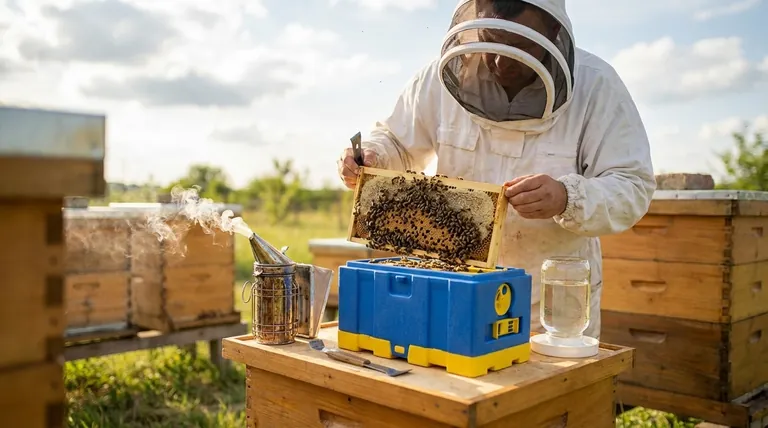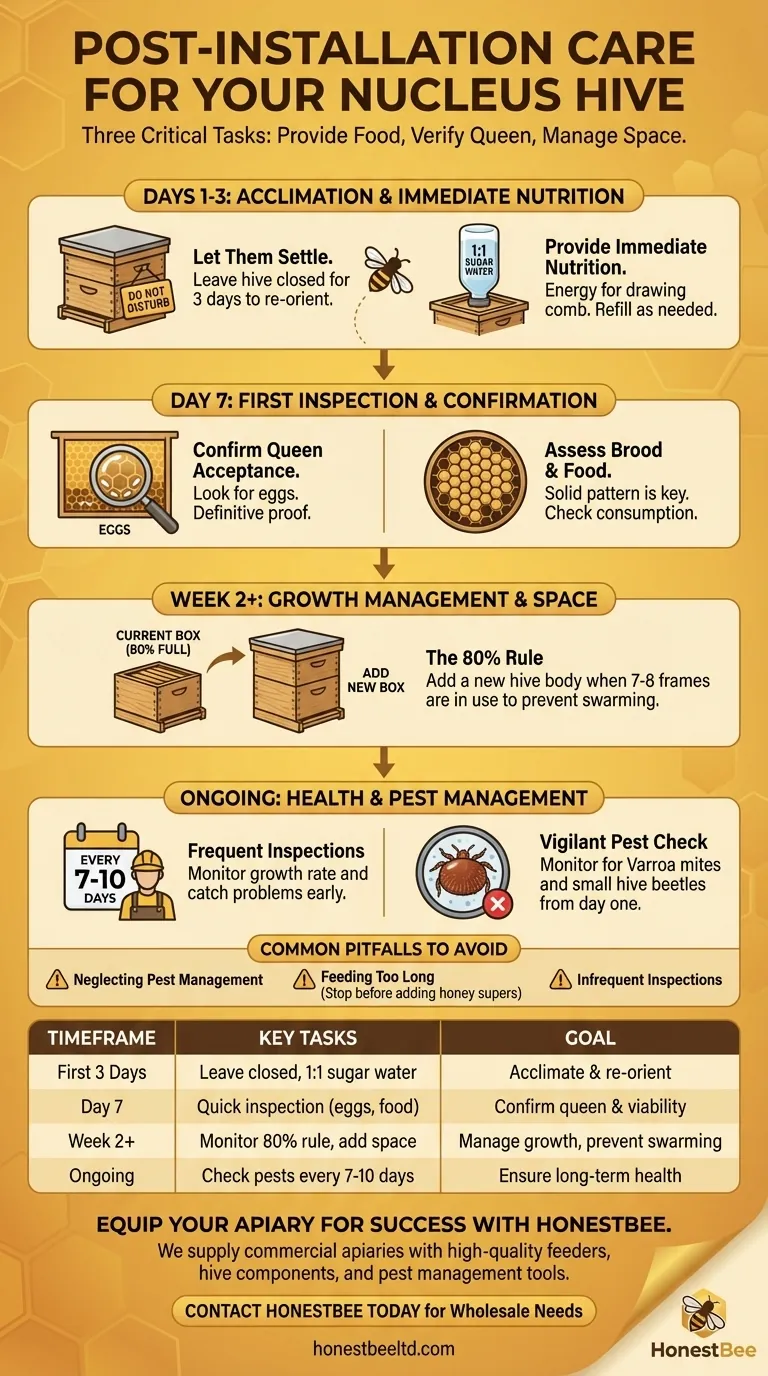The essential post-installation care for a nucleus hive boils down to three critical tasks: providing consistent food, verifying the queen is healthy and laying, and managing space to accommodate the colony's rapid growth. A nucleus hive, or "nuc," already has a laying queen, brood, and food stores, giving it a significant head start over a package of bees. Your primary job is to remove any obstacles that could slow down its momentum.
A nucleus hive is a colony in motion. Your post-installation goal isn't to start the engine, but to provide the fuel and clear the runway, ensuring the colony can build up to full strength without interruption.

The First Week: Confirmation and Support
The first seven days after installation are the most critical. Your actions during this period set the stage for the colony's success for the entire season.
Let Them Settle (Days 1-3)
For the first three days, your most important job is to do nothing. Leave the hive closed. The bees need this time to acclimate to their new home, re-orient themselves, and establish their routines without disturbance.
Provide Immediate Nutrition
Even though a nuc comes with some food stores, the colony will be working overtime to draw out new comb. This is an energy-intensive process that requires a significant amount of nectar or syrup.
Provide a 1:1 sugar water solution (equal parts sugar and water by weight or volume) in a feeder. This ensures they have ample fuel to build the wax they need to expand the brood nest and store resources.
Your First Inspection: The 7-Day Health Check
After about a week, it's time for your first inspection. This is not a deep dive; it is a quick, targeted check to confirm the colony is viable and on the right track.
Confirming Queen Acceptance
The single most important goal of this inspection is to verify you have a healthy, laying queen. You do not need to physically see the queen herself.
Instead, look for eggs. A healthy queen lays one tiny, rice-like egg at the very bottom of each cell. Finding frames with a solid pattern of eggs and young larvae is definitive proof that the queen is accepted and working.
Assessing the Brood Pattern
Look at the frames that came with your nuc. You should see a solid, consolidated pattern of capped brood (developing bees). A spotty or scattered pattern can be an early indicator of a problem with the queen or colony health.
Checking Food Consumption
Note how much sugar syrup the bees have consumed. A colony that is rapidly taking down syrup is a great sign of vigorous activity and growth. Refill the feeder as needed.
Managing Growth and Preventing Swarms
A successful nuc will grow incredibly fast. Your next challenge is to provide space before they feel crowded, which is a primary trigger for swarming.
The 80% Rule
A simple and effective guideline is the 80% rule. Once the bees have drawn out wax and are actively using 7 or 8 of the 10 frames in their current box, it is time to add a second one.
Waiting until all 10 frames are full can put the colony into swarm mode, which is difficult to reverse.
Expanding the Hive
To expand, simply place a new hive body with frames directly on top of the existing one. The bees will naturally move upward as they need more space for brood and food storage.
Common Pitfalls to Avoid
Understanding the unique characteristics of a nuc helps you avoid common mistakes that can set your colony back.
Neglecting Pest Management
A nucleus hive can come with pests from its original apiary. From your very first inspection, you should be vigilant for signs of varroa mites and small hive beetles. A nuc's head start is meaningless if it is overcome by pests early on.
Feeding Too Long
Consistent feeding is crucial for initial establishment and comb building. However, you should stop feeding before you add any honey supers that you intend to harvest for yourself. You want the honey in those boxes to be pure nectar, not sugar water.
Infrequent Inspections
In the beginning, check the hive every 7 to 10 days. This frequency allows you to monitor their growth rate, catch any queen problems early, and know precisely when to add more space.
Making the Right Choice for Your Goal
Your management priorities will shift slightly as the colony becomes established.
- If your primary focus is the first week: Concentrate entirely on confirming you see eggs, which proves your queen is healthy and accepted.
- If your primary focus is the first month: Prioritize consistent feeding and adding a second box as soon as the colony reaches that 80% threshold to prevent swarming.
- If your primary focus is long-term health: Transition from establishment tasks to a sustainable routine of monitoring for varroa mites and other pests.
By understanding and meeting these core needs, you empower your nucleus colony to transition smoothly into a strong, productive, and healthy hive.
Summary Table:
| Timeframe | Key Tasks | Goal |
|---|---|---|
| First 3 Days | Leave hive closed; provide 1:1 sugar water | Let bees acclimate and re-orient |
| Day 7 | Quick inspection for eggs & larvae; check food consumption | Confirm queen acceptance and colony viability |
| Week 2+ | Monitor for 80% frame usage; add new box before crowding | Manage growth and prevent swarming |
| Ongoing | Check for varroa mites & pests every 7-10 days | Ensure long-term colony health |
Equip your apiary for success with HONESTBEE.
A strong start is crucial for a productive season. We supply commercial apiaries and beekeeping equipment distributors with the high-quality, durable supplies needed to support nucleus hives and ensure rapid colony growth.
From reliable feeders and hive components to essential pest management tools, our wholesale-focused operations provide the equipment that underpins successful beekeeping.
Contact HONESTBEE today to discuss your wholesale needs and how our supplies can help your colonies thrive.
Visual Guide

Related Products
- 4 Frame Plastic Nuc Boxes for Beekeeping Bee Nuc Box
- Black Plastic Beetle Barn Hive Beetle Trap for Beehives
- HONESTBEE Advanced Ergonomic Stainless Steel Hive Tool for Beekeeping
- HONESTBEE Professional Long Handled Hive Tool with Precision Cutting Blade
- Wholesales Dadant Size Wooden Bee Hives for Beekeeping
People Also Ask
- What are the benefits of maintaining a nuc in beekeeping? Gain Control and Resilience for Your Apiary
- How does installing a nuc differ from installing a bee package? A Guide to Starting Your Hive Right
- What are some uses for a nucleus in beekeeping? A Guide to Apiary Growth and Resilience
- Why is a sound knowledge of beekeeping basics important when working with nuclei? Unlock Your Apiary's Full Potential
- How does colony growth differ between nucs and bee packages? A Guide to Faster Beehive Buildup



















